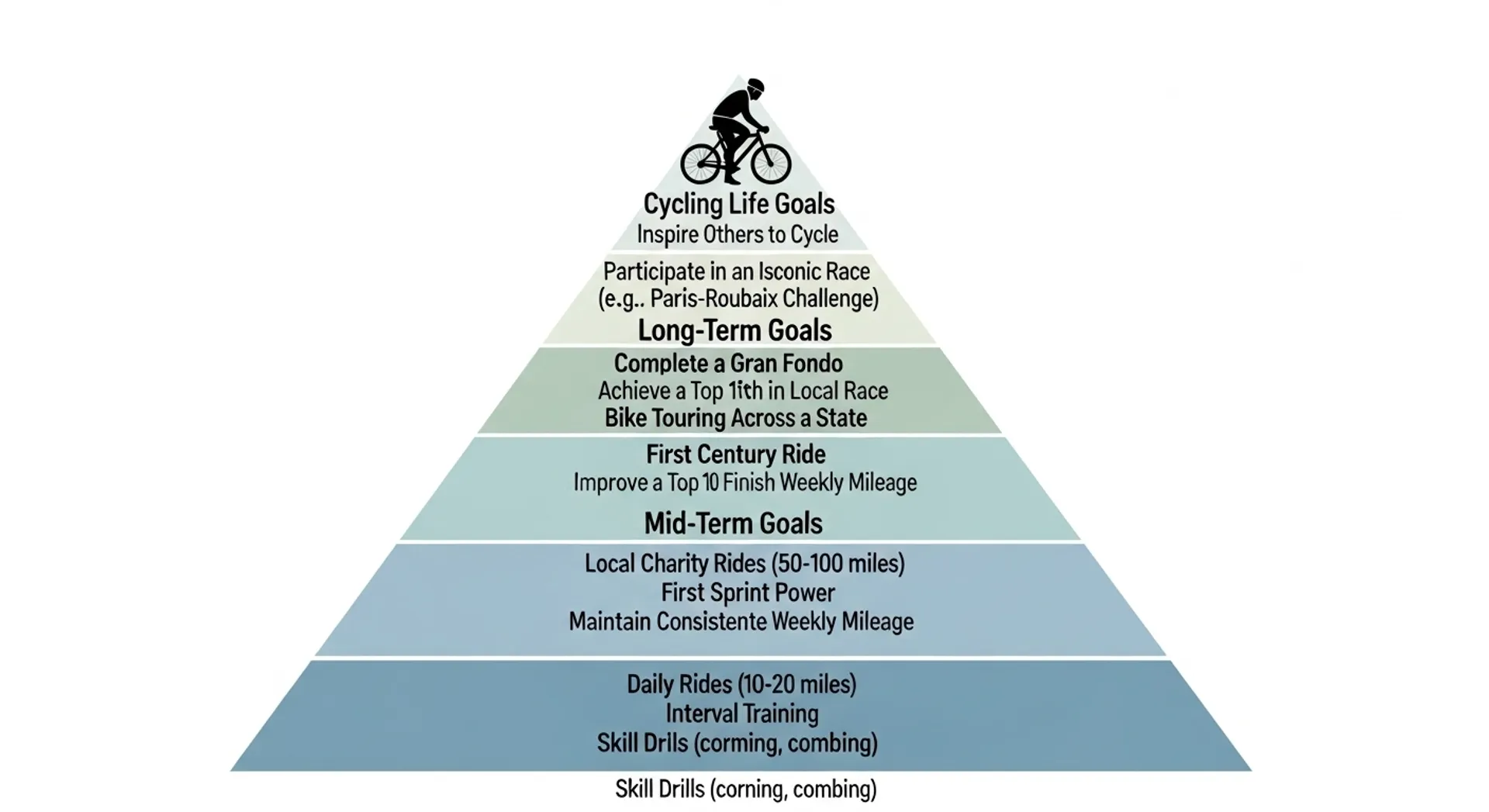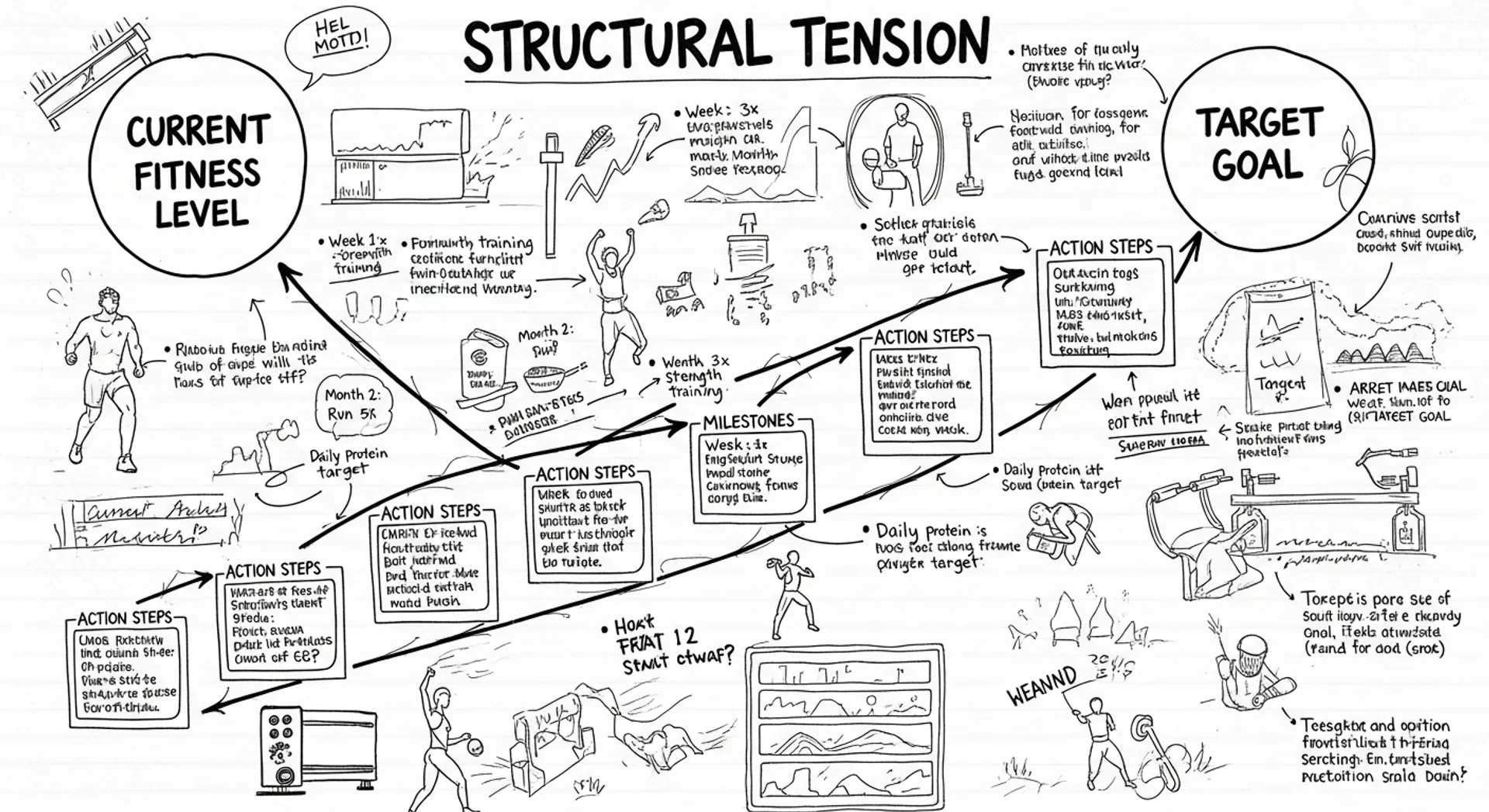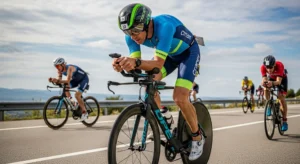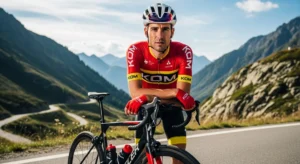We’ve all heard the timeless saying: “If you fail to plan, then you plan to fail.” Nowhere does this wisdom apply more directly than in cycling fitness and training. Whether you’re dreaming of completing your first century ride, improving your climbing power, or simply riding more consistently, the difference between achieving your goals and falling short often comes down to one thing — having a solid plan.
As we look ahead to the coming year, now is the perfect time to start choosing your cycling goals. Don’t wait until January when everyone else makes their New Year’s resolutions. Get ahead of the curve now and set yourself up for your best cycling year ever. The cyclists who achieve the most impressive results aren’t necessarily the most talented — they’re often the ones who plan most effectively and execute consistently.
The challenge many cyclists face isn’t a lack of ambition or desire. Instead, it’s the overwhelming number of variables to consider and methods for setting goals. This complexity can actually cause analysis paralysis, leaving you stuck in the planning phase without ever taking action. The solution? Keep things simple and focus on proven principles that actually work. Here’s a comprehensive framework for planning your cycling success, based on strategies that have helped countless athletes achieve their goals.
Breaking Down Your Goals Into Manageable Pieces
One of the most effective strategies for goal achievement involves breaking large objectives into bite-size morsels. This approach prevents overwhelm and creates a clear roadmap from where you are now to where you want to be. The key is distinguishing between short-term and long-term goals, then planning accordingly.
For planning purposes, consider short-term goals as anything achievable within six months or less. These might include increasing your weekly mileage by 20%, improving your functional threshold power by 10 watts, or completing your first metric century. Long-term goals extend beyond six months and often represent major milestones like completing a century ride, finishing a multi-day tour, or achieving a specific racing category.
The beauty of this timeframe distinction lies in building adequate padding into your plans. Life happens — injuries occur, work gets busy, weather doesn’t cooperate, and motivation fluctuates. By giving yourself plenty of time to achieve success, you create buffer zones that accommodate setbacks without derailing your entire plan.
Realistic Timeframes Prevent Injury and Burnout
Consider a practical example: if you’ve never ridden 100 miles and currently ride 5-10 miles a few times per week, attempting a century in three months would be aggressive and potentially dangerous. Your body needs time to adapt to increasing training loads. Tendons, ligaments, and aerobic systems all require progressive overload over extended periods to develop properly.
Instead, you might set a short-term goal of completing a 30-mile ride within three months, a metric century (62 miles) within six months, and your first full century within 9-12 months. This progression allows your body to adapt safely while building confidence through achievable milestones. Each successful shorter ride proves you’re capable of the next step, creating positive momentum.
The principle of progressive overload — gradually increasing training stress over time — forms the foundation of all effective training plans. Power meter training makes this progression measurable and objective. Rather than simply riding more miles and hoping for improvement, you can track specific metrics like functional threshold power, training stress scores, and power-to-weight ratios to verify you’re actually getting stronger.
The Power of Prioritization
After categorizing your objectives into short-term and long-term buckets, the next critical step involves setting priorities. This process separates wishful thinking from genuine commitment and forces you to identify what truly matters most to you this year.
Here’s an uncomfortable truth: setting too many goals virtually guarantees you’ll fail to achieve many of them. Life is complicated enough without adding unnecessary pressure and inevitable disappointment. Many cyclists make the mistake of creating elaborate lists of 10, 15, or even 20 goals for the year. While this enthusiasm is admirable, it’s rarely sustainable or effective.
Instead, try limiting yourself to three or four really important goals. This focused approach allows you to channel your energy, time, and resources toward the objectives that matter most. If you feel driven to set monthly goals throughout the year, that’s fine — just ensure each month’s goal supports one of your core priorities rather than pulling your attention in too many directions.
Ranking Goals by Importance
Once you’ve identified your handful of key goals, rank them in order of magnitude from “must accomplish” to “nice to accomplish.” This ranking serves multiple purposes. First, it clarifies which goal deserves primary focus when training time is limited. Second, it helps you make trade-off decisions when conflicts arise. Third, it prevents you from feeling like a failure if you don’t achieve every single goal.
For example, your priority ranking might look like this:
Priority 1: Complete a century ride by November. Priority 2: Increase functional threshold power from 220 watts to 250 watts. Priority 3: Lose 15 pounds to improve power-to-weight ratio. Priority 4: Complete a week-long bike tour with friends.
With this clear hierarchy, you know that if you can only train four days this week instead of six, you’ll prioritize rides that build century-distance endurance over shorter, higher-intensity efforts. You also know that if the bike tour falls through due to scheduling conflicts, you haven’t failed — you’ve simply missed a lower-priority “nice to have” goal while staying focused on what matters most.
Finding Your Why — The Motivation Behind Your Goals
Setting goals is easy. Achieving them requires something deeper — a compelling reason that keeps you motivated when training gets difficult. This is where finding your “why” becomes absolutely critical to success. Without a strong emotional connection to your goals, they remain abstract numbers and dates on a calendar rather than meaningful personal challenges.
One of the most effective tools for connecting with your motivation is something called a structural tension chart. This deceptively simple visualization technique creates clarity about both your destination and your starting point, while identifying the specific steps required to bridge that gap.
How to Create a Structural Tension Chart
Creating a structural tension chart requires just a blank page and honest self-reflection. At the top of the page, write your specific goal in clear, concrete terms. At the bottom, describe your current situation with equal specificity. Then fill the space between with the intermediate steps required to progress from bottom to top.
The magic happens when you answer the crucial “why” question for each intermediate step. Why must you complete this particular benchmark? What does achieving this milestone mean to you personally? How will your life be different when you reach this point? These answers provide the emotional fuel that powers you through difficult training sessions and temporary setbacks.
Here’s a detailed example of how this works in practice:
Long-Term Goal (at top of chart): Ride my first 100-mile century ride by the end of November and finish it in 6 hours or less. I’ve chosen El Tour de Tucson, which gives me 11 months to prepare. To achieve this time goal, I’ll need to average 16-18 miles per hour over the full distance. My power meter will help me train effectively and pace appropriately during the event.
Current Situation (at bottom of chart): I’m currently riding around my neighborhood for about 10 miles, once or twice per week, at a comfortable conversational pace. My average speed is around 13-14 mph, and I typically feel tired after these rides.
The Critical Middle Steps
Between these two points, you identify specific benchmarks with accompanying motivations:
Milestone 1 (Month 2): Complete a 20-mile ride at 15 mph average. Why this matters: This proves I can sustain a faster pace for longer than my current rides and builds confidence that the century goal is achievable. Successfully completing this milestone means I’m no longer a beginner cyclist — I’m becoming a real endurance athlete.
Milestone 2 (Month 4): Complete a 40-mile ride at 16 mph average. Why this matters: Reaching this benchmark demonstrates I can handle ride durations of 2.5 hours while maintaining goal pace. This is when I’ll start feeling like a “real” cyclist who can join group rides without holding others back. My fitness at this point will noticeably improve my energy levels throughout regular daily activities.
Milestone 3 (Month 6): Complete a metric century (62 miles) at 16 mph average. Why this matters: This milestone proves I’m over the halfway point in distance and can maintain goal pace for nearly four hours. Achieving this means I’ll have the confidence to sign up for the century ride and pay the registration fee, making the commitment real and official.
Milestone 4 (Month 9): Complete an 80-mile ride at 16-17 mph average. Why this matters: This is the final dress rehearsal before the main event. Successfully completing 80 miles means I can definitely finish 100 miles. At this point, the question shifts from “Can I do this?” to “How well can I do this?” My fitness will be at a level I’ve never experienced before.
Notice how each milestone includes not just the physical accomplishment but the emotional and psychological significance. This is where your “why” lives — in the meaning you attach to these achievements and how they connect to your self-identity and life satisfaction.
Implementing SMART Goal Principles
Once you’ve created the basic structure of your plan, it’s time to add detail and accountability through the SMART goal framework. This time-proven system ensures your goals include all the specificity necessary for effective planning and execution. SMART stands for Specific, Measurable, Attainable, Relevant, and Time-Bound — five characteristics that distinguish vague wishes from actionable objectives.
Specific: Clarity Drives Action
Vague goals produce vague results. “Get better at cycling” or “ride more” sound nice but provide no clear direction for your training. Specific goals eliminate ambiguity and create clear targets. Instead of “ride more,” specify “ride four times per week, with two rides over 25 miles and two shorter recovery rides under 15 miles.” Instead of “get stronger,” specify “increase functional threshold power from 220 watts to 240 watts.”
Specificity extends beyond just the outcome to include the process. How many days per week will you train? What types of workouts will you complete? What equipment or resources do you need? The more specific your plan, the easier it becomes to execute because you’ve eliminated decision fatigue — you already know exactly what you need to do.
Measurable: Track Progress Objectively
If you can’t measure it, you can’t manage it. Measurable goals allow you to track progress objectively and know definitively whether you’re on track or falling behind. This is where power meters and cycling computers become invaluable tools — they provide concrete data about your performance rather than relying on subjective feelings.
For the century ride goal, measurability comes from specific metrics: distance covered, average speed maintained, total elevation gain, and time to completion. For fitness improvements, you measure functional threshold power, heart rate at various intensities, and power-to-weight ratio. Each training ride generates data you can analyze to determine if you’re progressing as planned.
Attainable: Ambitious Yet Realistic
Attainable goals strike a delicate balance between ambition and realism. Set goals too conservatively and you won’t feel challenged or excited. Set them unrealistically high and you’re setting yourself up for disappointment and potential injury. The sweet spot lies in goals that require genuine effort and dedication but remain within reach given your current fitness, available training time, and life circumstances.
For someone currently riding 10 miles twice weekly, completing a century within three months would be unrealistic and potentially dangerous. However, completing a century within 9-12 months is ambitious yet attainable with consistent training. This timeframe requires dedication and progressive overload but doesn’t demand superhuman genetics or full-time athlete schedules.
Relevant: Alignment With Broader Life Goals
Relevant goals align with your broader values, priorities, and life circumstances. A goal might be specific, measurable, and attainable, but if it conflicts with other important aspects of your life, you’ll struggle with motivation and consistency. Ask yourself: Why does this goal matter to me? How does achieving this enhance my overall life quality? Does this align with my values and priorities?
For example, if health and longevity are core values, training for a century ride is highly relevant — it builds cardiovascular fitness, maintains healthy weight, and creates positive lifestyle habits. If connecting with friends matters to you, choosing a century ride that friends will also attend adds relevance. Conversely, if you’re in the middle of a career transition or have a new baby at home, this might not be the right time for such an ambitious cycling goal.
Time-Bound: Deadlines Create Urgency
Time-bound goals include specific deadlines that create urgency and focus. Without deadlines, goals tend to drift indefinitely into the future, always scheduled for “someday” which never actually arrives. Deadlines force action and help you structure your training appropriately.
The El Tour de Tucson in November provides a perfect time-bound element — registration opens on a specific date, the event happens on a specific day, and you either show up prepared or you don’t. This deadline works backward to structure your entire training plan, determining when you need to hit each intermediate milestone to arrive at the start line ready to succeed.
Practical Application: Your Century Ride Plan
Let’s bring all these principles together with a concrete example of how you might plan for completing your first century ride by November, giving yourself approximately 10-11 months of preparation time:
January-February (Months 1-2): Foundation Phase. Build base mileage with four rides per week, gradually increasing from current 10 miles per ride to 20 miles per ride. Focus on consistency and proper recovery. Target: Complete a 20-mile ride at conversational pace by end of February. Why it matters: This proves you can double your current ride distance and establishes a consistent training habit.
March-April (Months 3-4): Building Phase. Increase one ride per week to 30-35 miles while maintaining shorter rides for recovery. Introduce structured interval training once per week to build power. Target: Complete a 40-mile ride at 15-16 mph by end of April. Why it matters: You’ve now quadrupled your initial distance and can maintain goal pace for 2.5 hours.
May-June (Months 5-6): Development Phase. Extend your long ride to 50-60 miles every other week. Add a second structured workout focusing on sustained power at threshold. Target: Complete a metric century (62 miles) at 16 mph by end of June. Why it matters: You’re past the halfway point and can officially register for the November century with confidence.
July-August (Months 7-8): Peak Building Phase. Continue extending long rides to 70-75 miles. Include some rides with significant climbing if your century includes elevation. Practice nutrition and hydration strategies for long rides. Target: Complete a 75-mile ride at 16-17 mph by end of August. Why it matters: You’ve proven you can handle 6+ hours in the saddle while maintaining goal pace.
September-October (Months 9-10): Peak and Taper Phase. Complete your longest training ride (80-85 miles) in early September. Begin reducing training volume while maintaining intensity in early October. Focus on nutrition, sleep, and recovery. Target: Complete an 80-mile ride at 16-17 mph in early September, then arrive at November start line fresh and eager.
The Role of Technology in Goal Achievement
Modern cycling technology — particularly power meters — transforms goal setting from guesswork into science. Rather than training blindly and hoping for improvement, power meters provide objective feedback about whether your training is actually making you stronger and faster.
A power meter allows you to track your functional threshold power throughout your training cycle, verifying that the number is increasing as your fitness improves. It helps you pace long rides appropriately, preventing the common mistake of starting too hard and blowing up halfway through. It enables structured interval training at precise intensities that target specific physiological adaptations.
When combined with analysis software, power meter data reveals patterns in your training that would otherwise remain invisible. You can see exactly how much training stress you’re accumulating each week, whether you’re recovering adequately between hard efforts, and whether your fitness is peaking at the right time for your goal event. This level of insight was once available only to professional athletes with coaches and sports scientists — now it’s accessible to any cyclist willing to invest in the technology.
Maintaining Motivation Through the Journey
Even with perfect planning, motivation will fluctuate throughout your journey toward your goals. There will be days when training feels effortless and exciting, and days when even getting on the bike seems like an overwhelming chore. This is completely normal and expected — the key is having strategies to maintain forward momentum through both peaks and valleys.
Your structural tension chart serves as a motivational anchor during difficult periods. When you’re tempted to skip a workout or cut a long ride short, revisit your “why” statements. Remind yourself why each milestone matters and how achieving your goal will enhance your life. Visualize yourself crossing the finish line of that century ride, feeling strong and accomplished.
Finding training partners or joining a cycling club provides external accountability and social support that makes training more enjoyable and sustainable. When you know friends are expecting you for a Saturday morning ride, you’re far less likely to sleep in or make excuses. The social aspect of cycling can transform training from a chore into a highlight of your week.
Celebrating small victories maintains momentum and positive energy throughout the process. Each time you hit a milestone — whether it’s your first 30-mile ride, a new power record, or simply a week of perfect training adherence — acknowledge the accomplishment. These celebrations don’t need to be elaborate; simply recognizing your progress reinforces the behaviors that created that progress.
Adapting When Plans Need to Change
Even the best plans sometimes need adjustment. Injuries happen, work demands increase, family situations change, and life throws unexpected curveballs. The mark of a good plan isn’t rigidity — it’s adaptability. Building buffer time into your timeline creates space for setbacks without derailing your entire goal.
If you miss a week of training due to illness, don’t panic and try to make up all the missed work at once — that’s how injuries occur. Instead, accept the setback, resume training at a slightly reduced level, and trust that you’ve built enough time into your plan to accommodate this disruption. If a minor injury forces a two-week break from riding, consider whether you need to push your goal date back slightly or adjust your performance target.
The important thing is maintaining perspective and not allowing temporary setbacks to trigger an all-or-nothing mindset that causes you to abandon your goals entirely. Missing one workout doesn’t ruin your plan. Missing one week doesn’t erase months of progress. Life is messy, and successful goal achievement requires the flexibility to adapt while maintaining your commitment to the overall objective.
Beyond 2014: Building a Sustainable Cycling Lifestyle
While this article focuses on planning your success for a specific year, the ultimate goal extends beyond any single season or achievement. The real victory lies in developing sustainable habits and systems that support lifelong cycling enjoyment and continuous improvement. Each goal you achieve builds confidence and skills that carry forward into future objectives.
After completing your first century, you might set goals around completing a faster century, tackling a double century, completing a multi-day tour, or even trying competitive racing. The planning framework remains the same — break large goals into manageable steps, prioritize effectively, connect with your motivation, and use SMART principles to create actionable plans.
The cyclists who enjoy the most long-term success and satisfaction are those who view cycling not as a temporary fitness phase but as an integral part of their lifestyle. They don’t train obsessively for one event then stop riding for months. Instead, they maintain consistent training year-round, with goals that provide structure and motivation while allowing flexibility and balance with other life priorities.
Getting Started Today
The perfect time to start planning your cycling success is right now — not January 1st, not next Monday, not after the holidays. Every day you spend planning and preparing is a day closer to achieving your goals. Even if your goal event is nearly a year away, starting now gives you maximum flexibility and the best chance of success.
Begin with the exercises outlined in this article. Identify 3-4 key goals for the coming year and rank them by priority. Create a structural tension chart for your top goal, mapping out intermediate milestones with their accompanying “why” statements. Apply SMART principles to add specificity and accountability to each milestone. Set dates on your calendar and begin taking action immediately.
Remember that planning is just the first step — execution determines results. The best plan in the world means nothing without consistent action. But having a clear plan makes consistent action far more likely because you’ve eliminated ambiguity and created a roadmap to follow. You know what you need to do each week, each month, each training cycle to move progressively toward your goals.
Your Next Steps
Don’t let this article join the graveyard of good intentions that never became actions. Right now, today, take these three immediate steps:
First, grab a piece of paper or open a document and write down 3-4 cycling goals for the coming year. Don’t overthink this — just capture what excites you about cycling and what you’d like to accomplish. Second, rank these goals in order of importance and choose your top priority goal to focus on first. Third, create a basic structural tension chart for that top goal, identifying where you are now, where you want to be, and at least three intermediate milestones.
With these three steps completed, you’ll have more clarity and direction than 90% of cyclists who simply ride without specific objectives. You’ll have a foundation to build upon, refine, and execute throughout the year. Most importantly, you’ll have taken concrete action toward making your cycling dreams a reality rather than leaving them as abstract wishes.
Conclusion: Your Best Year Awaits
Planning your cycling success doesn’t require elaborate spreadsheets, expensive coaches, or complex periodization schemes. It requires clarity about what you want to achieve, honest assessment of where you are now, and a structured approach to bridging that gap. The principles outlined here — breaking goals into manageable pieces, prioritizing effectively, connecting with your motivation, and applying SMART criteria — provide a proven framework that works for cyclists at every level.
Whether your goal is completing your first century ride, improving your racing results, losing weight through cycling, or simply riding more consistently, the planning process remains fundamentally the same. Define your destination clearly, understand your starting point honestly, map out the intermediate steps, and connect emotionally with why achieving these goals matters to you personally.
The coming year holds incredible potential for your cycling journey. With thoughtful planning starting now, you can make it your best year ever on the bike. Don’t wait for January to join the resolution crowd — get ahead of the curve, create your plan, and start taking action today. Your future cycling self will thank you for the time and effort you invest now in planning your success.
Do you have specific questions about setting cycling goals or using your power meter for training? I’d love to help you with your training, nutrition, or weight loss journey as well. Please contact iBikeBlog and let’s work together to make your cycling goals a reality. Thank you for investing time in planning your success!




